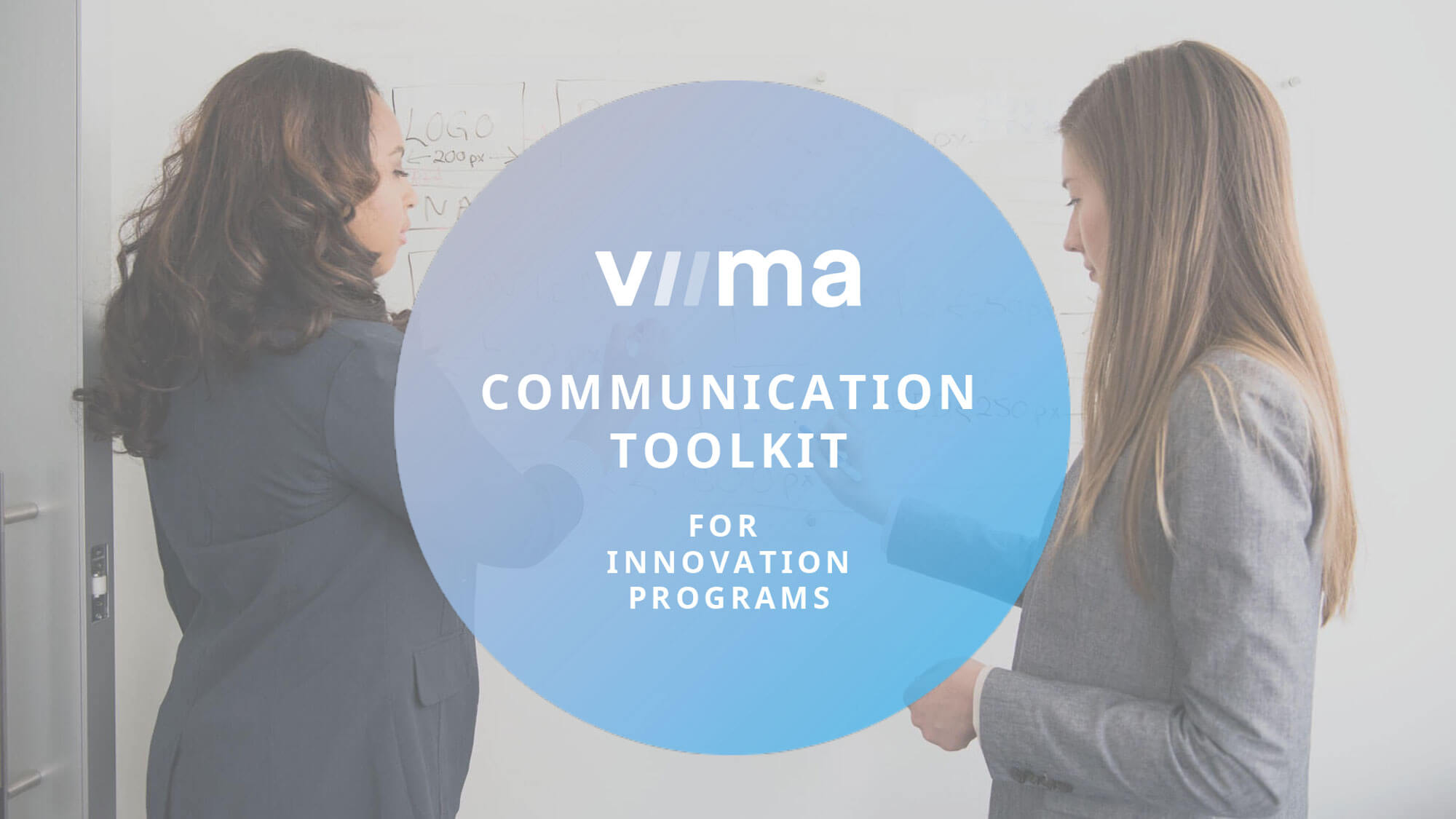The Role of Communication in Innovation Programs
As we talk to dozens of customers who are about to launch a new innovation program or campaign every month, we field a lot of questions on different topics. Yet, the one topic we get asked about almost every time is communication.
How should we communicate about the launch? What should we say? Which channels and formats do we use? How often should we be communicating? These are all great questions, and if you haven’t launched an innovation program before, it can be difficult to get started.
The good news is that it isn’t exactly rocket science. Just by keeping a few simple rules in mind and putting in some effort, you’re likely to do well even if you’re not a communications expert per se.
So, with that said, this article will serve as your one stop shop for figuring out the answers to these questions and for creating a communication plan for the launch of your innovation program, or a new initiative such as a campaign within it.
We’ve also put together a related toolkit that comes with a number of examples and templates that will help you create a solid plan quickly and easily, which you can download here.
But, without further ado, let’s get to it.
Table of contents

Why Is Communication Important?
Some of our customers like to launch their innovation program with a small scale pilot or two, some launch a large-scale campaign or challenge right away. Others may prefer to start their programs by focusing on continuous processes right away.
Each approach has their own merits, which we won’t go into more detail on this post, but regardless of the approach you choose, the role of communication is always the same.
In essence, that role is to tell the story of what you’re doing, why you’re doing it, and how that will happen in practice.
Communication matters at all stages of an innovation program, but it’s especially important during the launch as you need to tell everyone about the change and actually get them onboard.
If you don’t communicate at all, or do a terrible job at it, the consequences are pretty undesirable: you will have a hard time getting anyone to participate, and even the ones that do participate are likely focusing on all the wrong things and doing it all wrong.
If you don’t communicate at all, or do a terrible job at it, you will have a hard time getting anyone to participate, and even the ones that do participate are likely doing it all wrong.
However, the good thing is that if you do at least a decent job at it, the converse is true: people will know what is expected of them, they will be motivated to participate, and will actually do a better job at it.
What should the goals of your communication efforts be?
That brings us nicely to our next topic. Whenever you’re creating a communications strategy of any sort, you always need to have a clear picture of what the purpose of that plan is, and what your goals are.
This plays a big role in shaping your communications for one simple reason: you should always say everything that matters, but nothing more. If you say more than is necessary, you’re diluting the essential parts of your message, which will hurt your overall performance.
This is, of course, subjective, and there isn't single correct ratio, but the point is that to be effective, you have to be concise. And to be concise, you have to have a solid understanding of the big picture – and have clear priorities.
When it comes to communication in the launch of an innovation program, there are four key goals you should have in mind:
- Informing participants about the Why, How & What of your innovation program
- Guiding participants to focus on the desired outcome (=strategic goals)
- Achieving and sustaining active participation
- Improved quality of participation
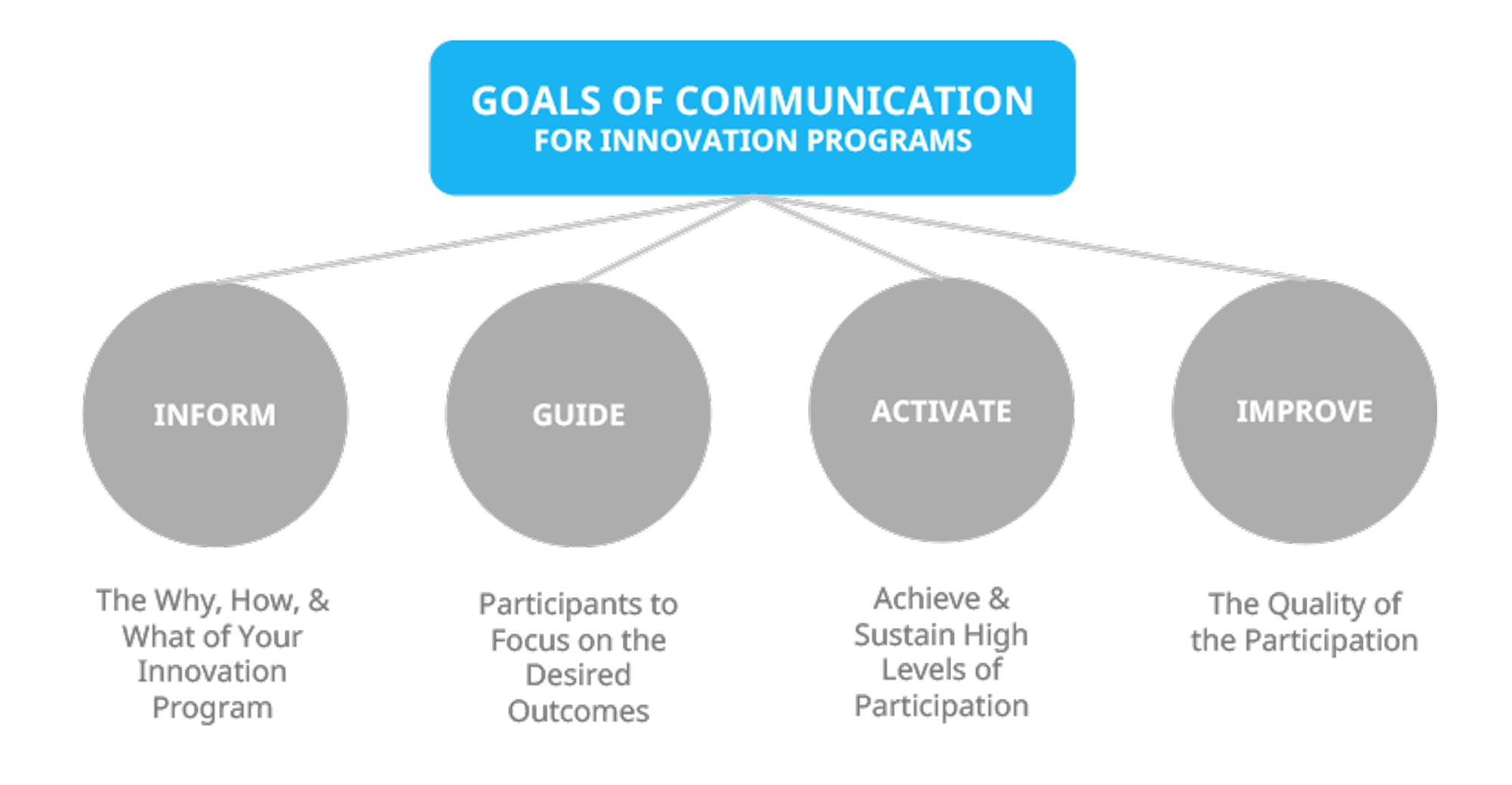
The first of these goals is pretty obvious, and the part that everyone focuses on. Let's, however, explore each of the other three goals briefly.
Guiding participants to focus on the desired outcome
As we’ve previously covered, innovation is a very wide topic, and one that almost every person seems to understand at least slightly differently.
As such, if you just ask people to come up with “innovative ideas”, the odds are that you won’t get what you were after. That’s where having an innovation strategy comes into play.
That’s obviously quite an extensive topic of its own, but at its simplest, it can mean just having a specific goal for your innovation activities.
If you’re looking to use innovation to cut down on costs, the ideas that people will come up with will obviously be very different from those that could drive revenue from completely new innovative products and services. What’s more, so will be the resources and capabilities needed for implementing said ideas.
So, the takeaway here is that to drive real business results, you should always have a very specific goal or outcome in mind for your innovation program, and for the different activities within the program. Once you communicate these desired outcomes to your participants, you are – surprise, surprise – much more likely to achieve those outcomes.
The more practical and tangible you can make these goals, the better.
For example, “100 ideas that can each help cut our annual costs by at least $10,000” is a very good, practical, measurable, and easy to understand goal.
Active and sustained participation
Perhaps the most obvious goal of your communication efforts is of course to get people to participate in the program in the first place.
Most people get that, but what they often forget to do is to have a plan in place for sustaining that participation. People are busy, and without active communication to remind them, other priorities can easily get in the way of them sustaining their participation.
Before we get down to the practicalities of how to achieve that, we should address the single most common question we get: what is a good participation rate?
We’ve written about this in more detail here, but the short answer is that for innovation programs aimed towards the employees of a company, our customers usually have 25-40% of the employees participating actively by leaving ideas or comments.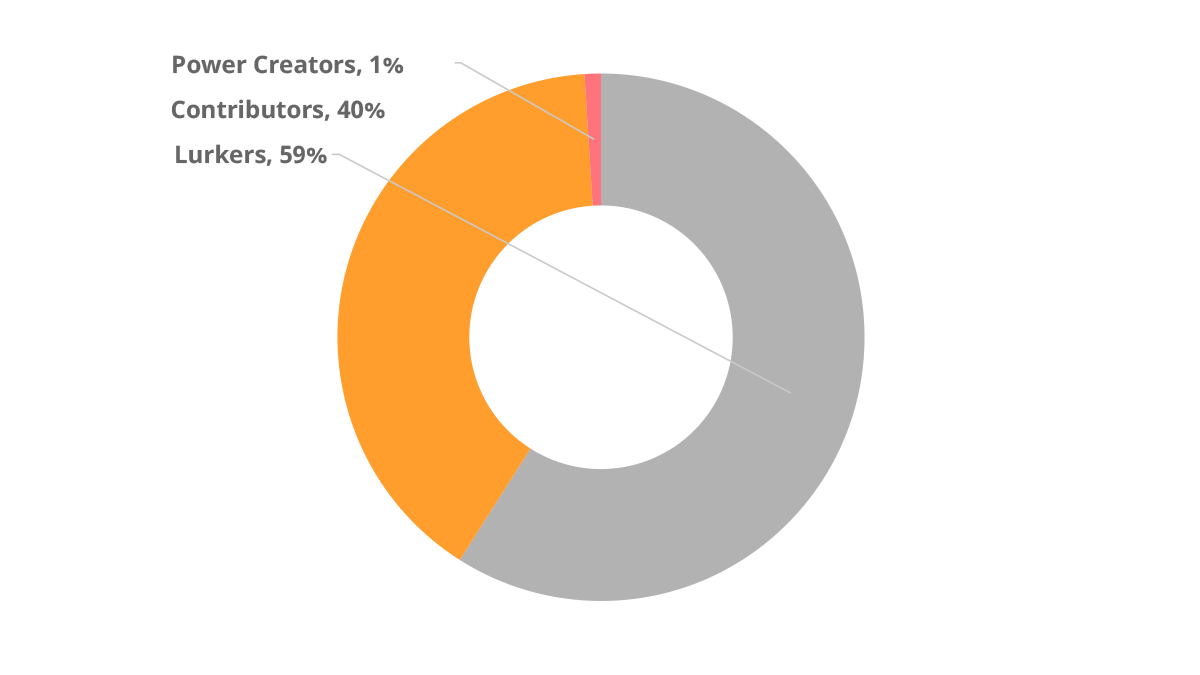 Anything below that means that either you probably didn’t do a very good job communicating the program, or in designing it to be of interest for the target audience.
Anything below that means that either you probably didn’t do a very good job communicating the program, or in designing it to be of interest for the target audience.
On the other hand, getting near or above the top of that range is an excellent achievement, and a clear signal that you’ve done a great job in planning and communicating the program.
How do you then do that? We’ll touch on the practicalities below, but the key idea is that you need to both inform and motivate the target audience to get them to participate.
You need to both inform and motivate the target audience to get them to participate. Tell them what you’re doing, but more importantly, why you’re doing it, and why it is in the best interest of each and every person to participate!
So, tell them what is that you’re doing, but more importantly, why you’re doing it, and why it is in the best interest of each and every person to participate!
If you’re having a hard time figuring out the why part here, think about the intrinsic motivators: meaning, choice, competence, and progress, and then apply those to your specific situation.
For example, cutting down on costs might not sound too exciting for anyone off the bat, but if you reframe the challenge to be about saving enough money to avoid laying people off, they are likely to quickly find that motivation because they’re now doing something that’s actually meaningful for a lot of people. Having the option to influence the situation and being able to help save other people’s (or even their own) jobs is usually enough to make most of us engaged.
Improved quality of participation
The third and final big goal for communication is about improving the quality of the participation.
As anyone who’s ever been in a workshop with dozens of people can probably attest to, just having more people participate doesn’t necessarily guarantee a better outcome, often the opposite can actually be true.
So, in addition to just having lots of people participate, your communication efforts should also extend towards improving the quality of that participation just like a facilitator would in our imaginary workshop.
In practice, part of this comes just reinforcing the messaging on the desired outcomes to remind people what to focus on – and what not to.
But the bigger and more often misunderstood part comes from facilitating the innovation work across the organization. A good communication plan for any innovation program isn’t just about sending a few messages, it always includes a lot of hands-on time working with people and managers across the organization to help them refine their ideas. Sometimes, especially in smaller organizations, you can get away doing all of that yourself, or with a few people, but in any organization of meaningful size, you’re going to need to involve a lot of “innovation champions” from across the organization to help you with this job.
Sometimes, especially in smaller organizations, you can get away doing all of that yourself, or with a few people, but in any organization of meaningful size, you’re going to need to involve a lot of “innovation champions” from across the organization to help you with this job.
Usually, line managers are the most natural fit here, but depending on your organizational structure, this could also be individual experts or dedicated facilitators. So, have a plan for training and educating these champions on their responsibilities, namely reinforcing and repeating the message, and even more importantly, facilitating the discussion that helps refine those ideas.
Best practices and practical guidelines
Now that we have a better understanding of the big picture, we can move on to the practical details. We’ll cover the most common practices and seek to provide you with some practical guidelines on how to choose the right approach for your initiative.
Having said that, in the end, the best and really only way to know for sure is to try the approach out and adapt accordingly as every organization is different. As such, while you definitely should create a communications plan, we always recommend you test your first draft of that with a small audience before launching it at a larger scale.
Messaging
The first part, messaging, is also the most important to get right. If you get the message wrong, it really doesn’t matter how often and where you communicate.
The Golden Circle, as elaborated by Simon Sinek in his famous TED talk, is a simple rule of thumb for doing communication well. In essence, the idea is that you should start with the WHY, then proceed to the HOW, and only in the end, talk about the WHAT.
Most people organizations only talk about the WHAT part, and then end up wondering why no one got interested in what they were talking about, let alone knew how to participate and what was expected of them.
So, great communication about innovation programs starts by you explaining why you’re doing the program, what your goals are, and why people should care, then goes on to explain how the program works, and finally ends up with the summary of the program, the What. As long as you keep that simple structure in mind, you’ll probably do well.
However, there still are a few additional guidelines we recommend:
- Be concise and to the point. As mentioned, say everything you need to say, but nothing more.
- Don’t just inform, try to inspire and motivate. This comes back to the need for the Why. If you just inform and tell the What, and maybe the How, people just won’t care. They’re all busy and if you can’t tell why they need to change their priorities, they won’t.
- Show people their input is actually valued. Everyone says: “we want your feedback”, but few truly mean that. Smart people will sense when this is the case, so make sure you actually want input from your target audience and then put your money where your mouth is. When you get your first pieces of feedback, praise that publicly. Even better if you can implement some of the ideas right away.
- Test and iterate. Messaging is really hard to get perfect right away. The best in the business perfect their messaging by first testing it out on a smaller scale and then making changes based on the reception they get before they proceed to roll it out with a big launch. That’s one of the real secrets behind pretty much every great communicator.
Channels
Once you know what your message is, the next very practical decision you’re faced with is about the communication channels.
What the right set of these channels is depends wildly based on a lot of factors, but the most important is who you’re targeting with the campaign. In the end, you can only use channels where you can effectively reach your audience.
Just having a single communication channel for your innovation program would of course be nice in keeping things simple, but the problem is that if you’re planning to reach a large proportion of your target audience, odds are that you won’t be able to reach all of them via any given channel.
Also, for communication to be effective, you need to repeat the message a lot. We’ll come back to this topic later in the article, but for now, just know that having a mix of a few different channels usually helps you achieve a sufficient level of repetition without it becoming annoying.
The key to succeeding with this is to alter the messaging and the format to the unique characteristics of each channel. We all intuitively know that what works on Instagram probably isn’t ideal for LinkedIn, and the same applies for our innovation program, even if the actual channels are different.
In other words, don’t send the same exact message in Slack as you do via email, but keep the core message the same.

For most organizations and most innovation programs, we recommend using between 3-5 communication channels. 2-3 of these should usually be your primary channels, with 1-3 additional channels reinforcing the message.
Primary channels are the ones where the majority of communications will happen, secondary channels are simply ways to remind people to participate and reinforce the messaging around that.
We recommend most organizations and most innovation programs to use between 3-5 different communication channels. Keep the core message the same but alter the format for the characteristics of each channel.
As a rule of thumb, you should choose the channels that your audience pays the most attention to, as well as the ones where you’d like them to be active on, as the primary channels.
So, for example, if none of your employees uses your intranet on a daily basis, as is usually the case, you probably shouldn’t use that as anything more than a secondary channel.
In the case of this example, you'd instead, focus your efforts the team chat (Microsoft Teams, Slack, etc.), as well as the idea and innovation management platform (e.g. Viima), you use to run the program. These two primary channels would then with a couple of additional channels for reinforcing and repeating the message, such as your innovation champions.
We’ll next give our quick takes on the most commonly used methods for internal communication within large organizations.
- Email is still one of the most active communication channels in most organizations, and even if it’s far from perfect, it should usually be included in most innovation program communication plans.
- Internal chat tools like Microsoft Teams and Slack are also usually active and very effective channels for communication. If you’re using one, we recommend you always include this on your communication plan. However, the key here is to find the right channels or teams to spread the message: pick the ones where your audience is the most active, and always have more than one of them in the plan.
- The idea management platform is an important channel for reinforcing the messaging and sustaining participation but isn’t usually great at driving initial adoption. So, include this in your plan and focus your communication efforts in guiding the collaboration. Also, make sure you’re using the features of the platform such as automated notifications and mentions to keep the conversation active.
- Intranets and internal social networking tools like Yammer are usually not very active in most organizations and people generally aren’t using them on a daily basis. As such, we recommend not focusing your efforts on these channels. If you have them, and people are actually using them, you might want to share the message there too, but with minimal effort.
- 1-on-1 channels like SMS and IMs can be very effective in reminding and activating people, but usually aren’t great for initial communication about your program. If you really need to get a hold of someone later on during the campaign, consider these.
- Flyers, posters, rollups etc. in physical spaces can be a good way to reach employees and spring up conversation in the front lines of companies where employees don’t usually do much electronic communication in the day-to-day.
- Team managers, supervisors and other innovation champions/thought leaders are probably the most underused and unappreciated, but by far the most effective communication channel! In the end, they are the ones working with your employees daily and have the most authority on what people spend their time on and what not. We’ve never seen a program that wouldn’t have been a resounding success in terms of active participation if the majority of managers are onboard and active. On the other hand, employees will ask their managers about your innovation program, and if they’re skeptical or negative, you will usually struggle to achieve your goals.
Team managers and supervisors are probably the most underused and unappreciated, but by far the most effective communication channel!
Ideally, you’d involve these managers and supervisors already in planning your innovation program to make sure their points of view are considered and worries addressed. This helps win over their support for the program down the road.
However, even if you don’t, make sure to educate them on your campaign prior to launch to make sure they’re onboard and know what to do to support the campaign on the ground. Typically, a single workshop followed up with some 1-on-1 messages to remind them of their responsibilities is an effective approach.
Formats
With the message and channels taken care of, the next topic for us to focus on is the format of the communication.
As with channels, there isn’t just a single right format here either. It again depends on your target audience and the channels you’ve chosen. An email to managers and a physical poster to front-line employees obviously have very different characteristics and thus benefit from different approaches.
However, as the channels that most organizations focus on are digital, with the exception of 1-to-1 discussions (which should always a part of your plan), we’ll be focusing on the digital formats here as well.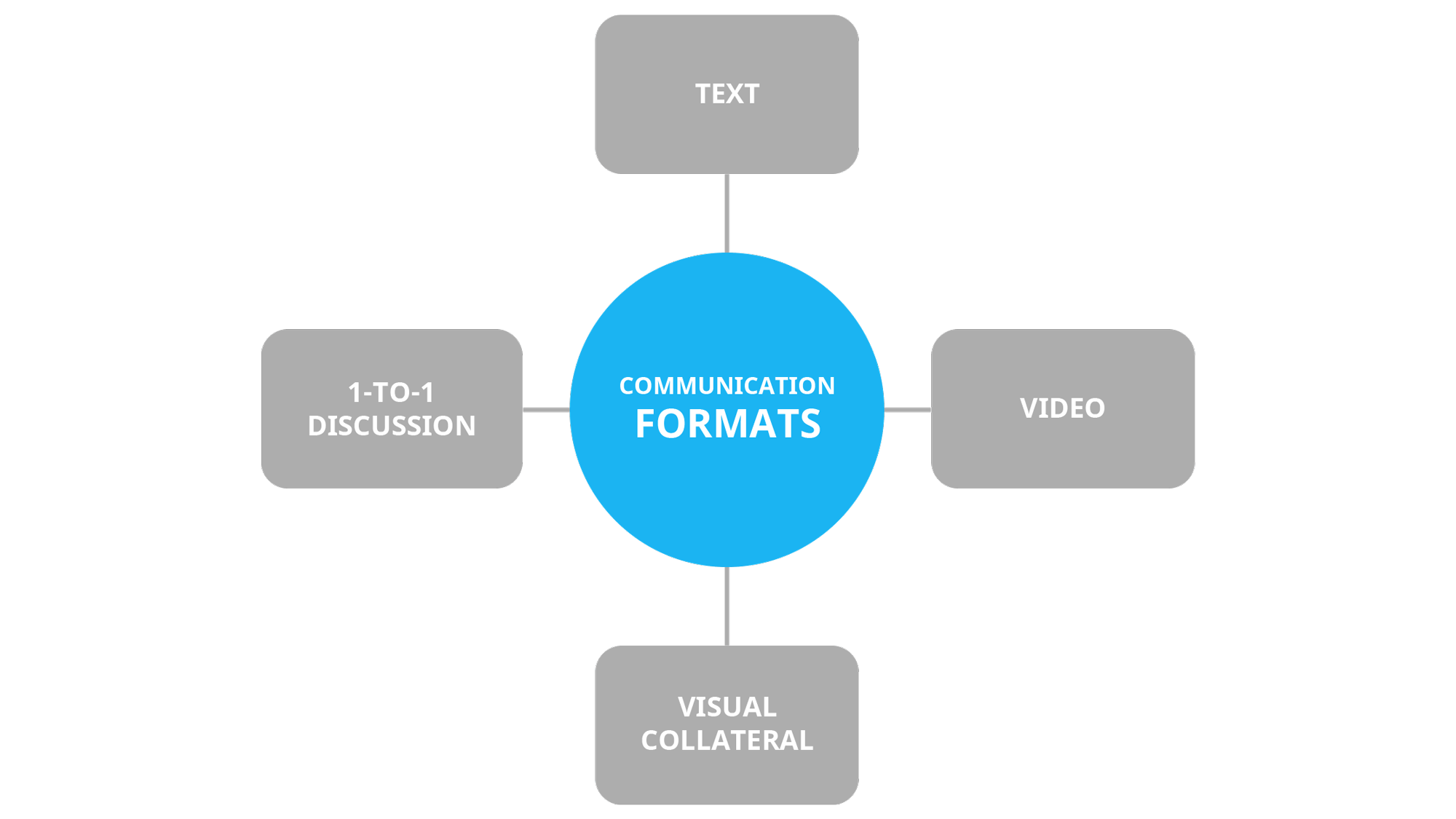 For quick and simple initiatives within your innovation program, mostly text-based communication is usually fine.
For quick and simple initiatives within your innovation program, mostly text-based communication is usually fine.
An example of this is an idea campaign aimed at a specific unit within a larger organization. You can likely focus your efforts on just sending purely text-based, well-formatted messages on the Teams/Slack channel of that unit, use the automated notifications within your idea management platform, and then simply have managers within the unit promote the initiative to their teams, follow up with individual team members and facilitate them refining the ideas.
However, when you move on to more complex, longer lasting, or simply larger initiatives, you will need to add visual communication to the mix.
For many people, this is super helpful in getting the message across. In these cases, PDFs and maybe even physical collateral quickly become very important. We have created a toolkit that contains canvases and templates you can use as the basis for some of these materials, so make sure to check those out.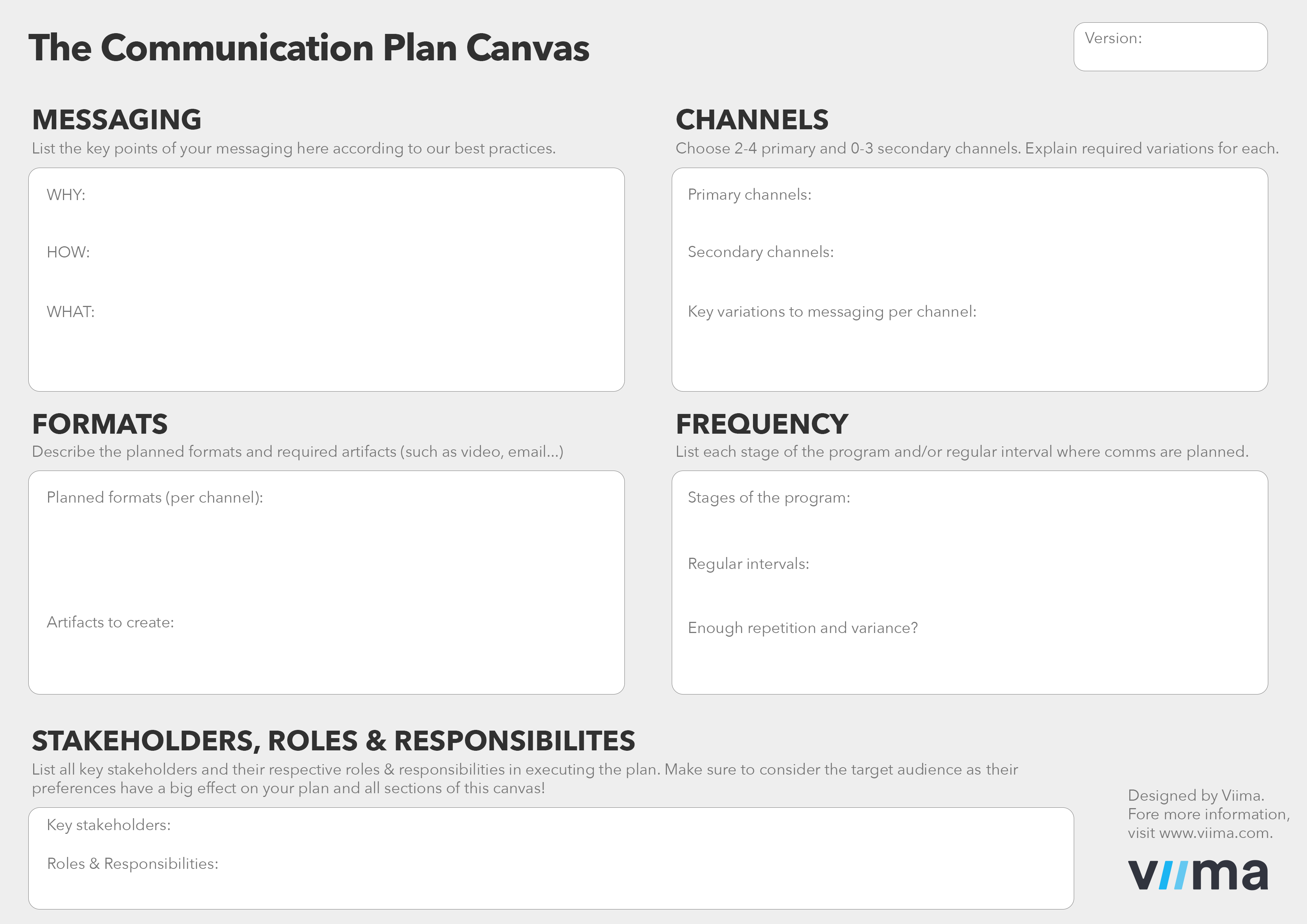 In addition, we’ve seen short introductory videos work really well. They help you convey more information quickly, and many people find them to be a lot more engaging. What’s more, these can easily be used in almost every channel. For example, you can obviously easily link to them on your emails and other electronic communication and if you use Viima or other modern idea management platforms, you can include these on the platform to welcome new users and provide with the context they need.
In addition, we’ve seen short introductory videos work really well. They help you convey more information quickly, and many people find them to be a lot more engaging. What’s more, these can easily be used in almost every channel. For example, you can obviously easily link to them on your emails and other electronic communication and if you use Viima or other modern idea management platforms, you can include these on the platform to welcome new users and provide with the context they need.
Here are a couple of tips for getting your formats right:
- If you have them, keep the videos short. Around 2-3 minutes is usually a good starting point for balancing detail and conciseness.
- Make sure to use the WHY-HOW-WHAT format described above for the messaging, regardless of the actual format.
- Don’t worry about the production values of possible videos. It’s completely fine to use a good smartphone camera, or a tool like Loom or Vidyard. Just focus on getting the message right.
- If possible, have a C-level sponsor do some of the communications, such as that video, to show that this really matters for the company.
- Be authentic and relatable. Don’t create a fluffy corporate comms plan, such as a video with elevator music and the CEO reading a script they obviously don’t mean. This will just make your employees cringe. In some cases, low production values can actually be helpful with this.
- Make sure to also talk about the practicalities, for example:
- Why are you doing this and why should people participate?
- What are the tangible goals for the initiative?
- How does the process work?
- How can people actually participate, in practice?
- What do you expect from each participant?
Frequency
The final piece in the communication puzzle is frequency. How many times, and how often, should you communicate?
Well, the first thing you should understand is that repetition has been proven to be the key for all kinds of communications.
There are many studies on this, and exactly how many times you need to repeat a message before people remember and internalize it, let alone take action, seems to depend a lot on the context and the audience. However, 3-20 times would seem to be the usual range for most kinds of communications.
You will, on average, need to repeat your message 3-20 times before people start to remember and internalize it, let alone take action. Most people err on the side of too little repetition.
Most people, thus, err on the side of too little repetition. The reason for this is pretty simple. If you’re already very familiar with a given topic, it’s very natural to assume that most other people are somewhat familiar with it too, but that usually isn’t a valid assumption.
However, you don’t also want to spam people as this might turn against you too. So, the key is to find the right balance between having enough repetition, and too much repetition.
One of the keys to achieving this is to plan your communication campaign so that includes variance. Variance is highly effective for a few reasons:
- it keeps things interesting for the audience
- different angles work for different people
- slightly different versions of the same message also help people focus in on what stays the same, and thus truly matters
Variance, however, comes naturally when you include a mix of different channels in your plan and spread it through time as your innovation program moves along. So, don’t spend too much time thinking about and worrying about variance.
Bringing these points into practice, the number of messages you need to send and communications you need to do to reach your goals, is actually relatively similar regardless of the length of your campaign.
The reason for this is that regardless of the length of the campaign, you need a reasonably similar level of repetition, and you also need to communicate a lot of the same practicalities anyway. It’s only when your program runs on for an extended period of time, or indefinitely, that you need to add in reminders at regular intervals to keep things going and active.
Regardless of the length of the campaign, you need a similar level of repetition, and you also need to communicate a lot of the same practicalities. Thus, shorter campaigns require much more intensive communication, and you need to allocate enough resources for achieving that.
Thus, shorter campaigns require a much more intensive communication program, which in turn means that you need to allocate a lot more resources for achieving that. So, for short (less than 2 months) idea challenges with a large target audience, we usually recommend having at least one FTE (full-time equivalent) allocated for communications and the facilitation and management of the campaign.
On the other hand, for longer programs or continuous processes, these responsibilities are usually easy enough to divide to team members in addition to their normal work, so a full-time communicator/facilitator typically isn’t necessary.
To explain what all of this means, there’s a summary of the things you should be prepared to do during each phase of your idea challenge or innovation program below. Some of these are only applicable to limited-time challenges and some for continuous processes, but most apply to both.
Things you always need to do:
- Communicate the launch of the program/campaign
- Communicate the end of a campaign
- Communicate when the program changes or the campaign moves to the next stage
- Active communication & facilitation during idea development to help refine ideas and challenge participant’s thinking
- Active communication regarding decisions being made and the rationale behind them
Things that are usually good to do:
- Heads-up communication a couple of days before launch
- Reminders a couple of days before the end of a campaign or each deadline within it
- Periodic reminders for participants (e.g. weekly). This is especially important for continuous processes and longer campaigns.
Launch is just the beginning
Even though this article is primarily about communication during the launch of an innovation program, it’s important to understand that launch is just that, the beginning of something new.
Thus, your communication plan, just like your innovation program overall, shouldn’t obviously be limited to the launch.
Launch is super important for getting things off the ground and to the right trajectory, but if innovation and related communications aren’t a continuous process, but just a set of one-off campaigns, you’ll never be able to get to your full innovation potential.
Innovation requires a lot of hard work and persistence. There are quick wins there that are usually worth going after, but you just need to commit to it in the long term and really get your hands dirty. This is also what you need to tell in your communication, and your messaging, during launch.
This is also what you need to tell in your communication, and your messaging, during launch.
An example of how you could do that is: “What we’re now doing is just the beginning. We, as an organization, see innovation as a top priority and are committed to investing a lot of resources to it for the long-term, and we need every single one of you to participate to succeed in it. This is new to most of us, so any ideas and feedback on how we can best reach these goals is highly appreciated.”
What you should strive to achieve is an end state where everyone, regardless of their place in their organization, gets innovation, knows why you’re doing it, what they can do to help get there, and why it’s in their best interest to do so.
What you should strive to achieve is an end state where everyone, regardless of their place in their organization, gets innovation, knows why you’re doing it, what they can do to help get there, and why it’s in their best interest to do so.
Conclusion
We’ve covered a lot of ground in this article, but to conclude, communication plays a key role in the success of every innovation program. Thus, you need to plan for it and dedicate resources to it, and that doesn’t just mean ordering a bunch of flyers or commissioning an agency to create a video for you.
They key is winning people, especially managers, over from across the organization and having them commit to being a part of your communication plan already before the launch of your innovation program.
It isn’t rocket science, but there’s a lot of hard work in getting all of that done. To help you with all of that, we’ve put together a highly practical toolkit that comes with a lot of templates, canvases, plans and examples that you can build your communication plan on top of. You can download the toolkit here.
Best of luck with your program!
Interested in Innovation and Leadership?
Subscribe to our blog to get the latest stories on innovation, leadership and culture straight to your inbox.
